The article first appeared in the autumn 2004 issue of the Expert Witness.
Introduction
It is important, when predicting the lifetime income of a young plaintiff, to be able to identify the educational level that individual would have achieved, had he or she not been injured.
The economics literature contains numerous studies that have investigated the determinants of educational attainment. But all of these studies attempt to explain only tendencies in choice of education. Whereas they can tell us whether a minor is “more likely” to obtain post-secondary education if he or she comes from one socio-economic background than from another, they rarely attempt to predict the magnitude of these effects.
As a result, the literature is of only very general assistance to the court. In this article, we present the results of detailed statistical analyses we have undertaken, using a recent set of data compiled by Statistics Canada, that will allow us to provide more detailed predictions of educational attainment than have previously been available.
The Data
The data we employ, from the 2001 General Social Survey, allow us to compare the educational attainment of Canadians aged 30-39 with numerous characteristics from their family backgrounds.
Specifically, for each of approximately 5,000 survey respondents, we know whether the individual: failed to complete high school, completed high school, took “some” schooling beyond high school, completed a college diploma or trade certificate, or completed university. We have similar information for each of the respondent’s parents; and information about the respondent’s province of birth (or whether he/she was an immigrant), religion, and first language. We also know whether each respondent was an only child, whether the respondent lived with both of his or her parents while a child, and what size of city the respondent lived in when a child.
Table 1 presents a complete list of the variables available to us, along with their means and standard deviations. Notice that, with the exception of the education of the respondent at age 30-39, all the information presented in Table 1 would have been available when the individual was a teenager. Thus, if the respondent’s educational attainment is found to be correlated with that information, it may be possible to predict the ultimate education of individuals who are currently in their teens.
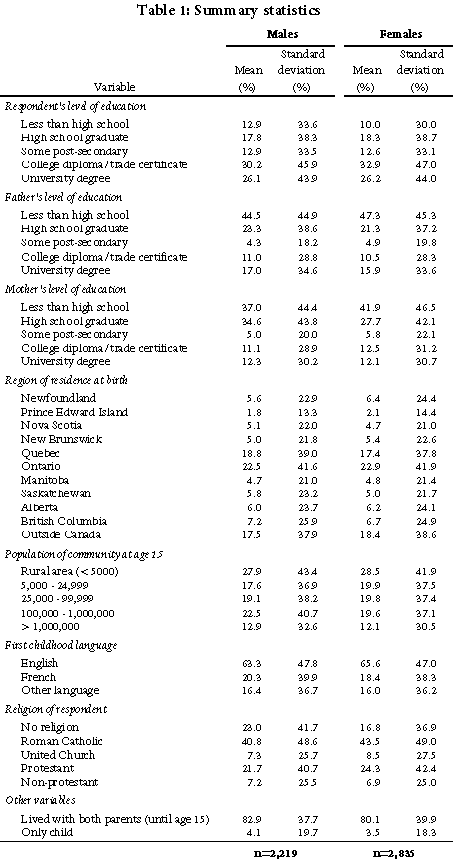
Statistical Analysis
We subjected the data to a statistical technique known as regression analysis in order to determine which of the socio-economic variables were most closely correlated with educational attainment. We found that only three categories of variables had statistically significant effects. These were: the education of the parents, whether the individual lived with both of his or her parents until age 15, and (to a lesser extent) the population of the community in which the individual lived at age 15. Variables that proved to have no (or little) significant effect on educational attainment were: province of birth (if Canadian), whether the individual was an only child, immigration status, mother language, and religion.
Most importantly, we were able to use the results of our analyses to predict the probability that the respondent would achieve each of the five education levels, based on: parental education, whether the respondent lived with both parents until age 15, and the population of the community in which the respondent lived at age 15.
Parents’ Education
Tables 2 and 3 provide detailed information concerning the impact of parental education on the educational attainment of sons and daughters, respectively. As an example of how to read these tables, the top left box in Table 2 indicates that if both the mother’s and the father’s educations were less than high school (“< High School”), the probability that their son would also obtain less than high school education was 21 percent. The probability that he would finish high school was 24 percent, would finish “some” post-secondary schooling was 14 percent, would finish a trade or college education was 28 percent, and would finish university was 14 percent.
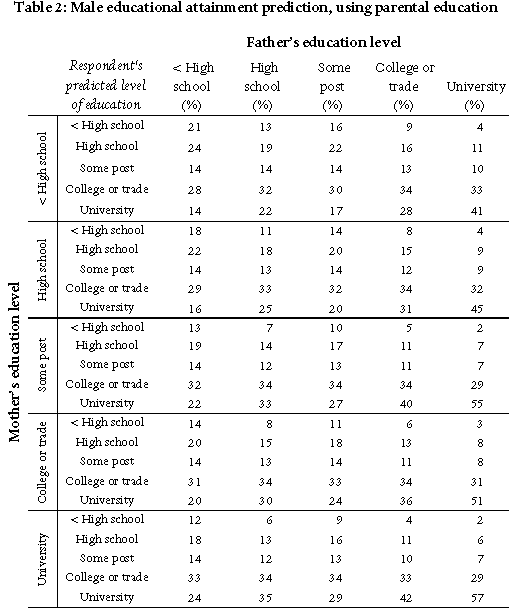
Table 2 also indicates that, for males, the probability of completing the two “middle” levels of education – “some university or college” or
“college/trade school” – is not strongly influenced by parental education. For example, the probability of completing college or a trade varies only from 28 percent (when both parents had less than high school or had university) to approximately 34 percent (all other parents); and the probability of completing some college or university varies from 7 percent to 14 percent.
Similarly, Table 3 indicates that, for females, the probability of completing college or a trade varies only from 26 percent (when both parents had university) to 36 percent (most other parents); and the probability of completing some college or university varies from 5 percent to 15 percent (with a much smaller range if university educated parents are omitted).
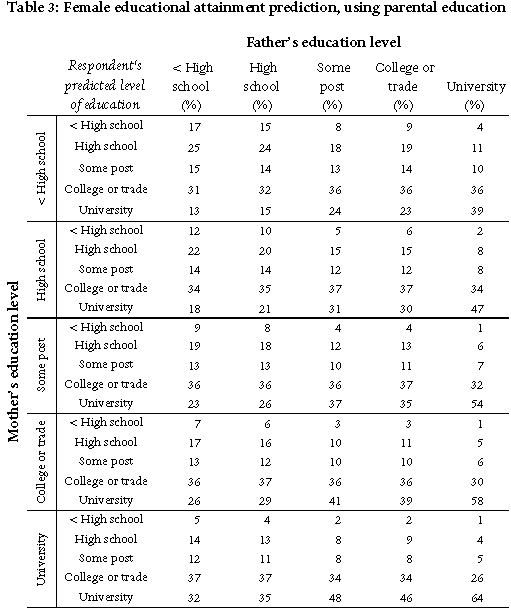
At either end of the educational range, however, parental education is a much more important predictor. When both parents have less than high school, for example, the probability that the child will complete high school or less is 42 percent for females (25 percent high school plus 17 percent less than high school) and is 45 percent for males; whereas when both parents have university educations, these probabilities fall to 5 and 8 percent, respectively.
Conversely, the probability that children will obtain university education rises from 13 percent for females and 14 percent for males, when both parents have less than high school, to 64 percent for females and 57 percent for males, when both parents have university degrees.
Furthermore, a one step change in parents’ education at either end of the educational range can have a dramatic effect on the child’s educational attainment. For example, whereas the probability that males would complete high school or less was 45 percent when their parents both had less than high school, that probability fell to 29 percent when their parents had completed high school.
And whereas the probability that females would complete university was 64 percent when both parents had also completed university, that percentage fell to 39 percent when both parents had college degrees or trade certificates.
Finally, it is important to note that the child’s educational attainment is influenced by the education of both parents. At most levels of education, an increase in the mother’s education has virtually the same effect on the child’s educational attainment as does an increase in the father’s education.
Lived with Both Parents
We were also able to use our statistical analyses to predict the effect that living with both parents had on individuals’ educational attainments. These predictions are reported in Table 4. There it is seen that, although living with both parents had a statistically significant effect on the child’s educational achievement, for practical purposes the impact is small. In particular, among both males and females, those who lived with both their parents were approximately 6 percent less likely to drop out of school before completing high school, and 9 percent more likely to complete university, than were those who lived with only one parent.
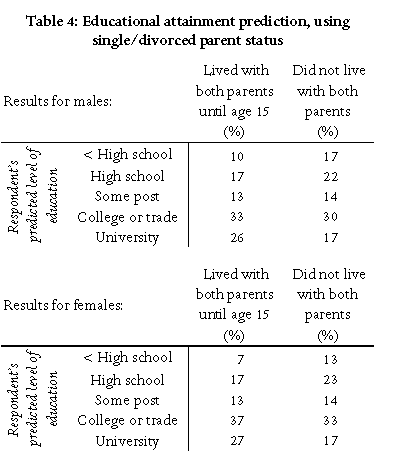
Urban/Rural
Finally, Table 5 indicates that population of the area of residence makes very little difference to the educational decisions of females and has an important effect on the decisions of males only in very large cities, where males are approximately 10 percent more likely to attend university than are residents of smaller areas.
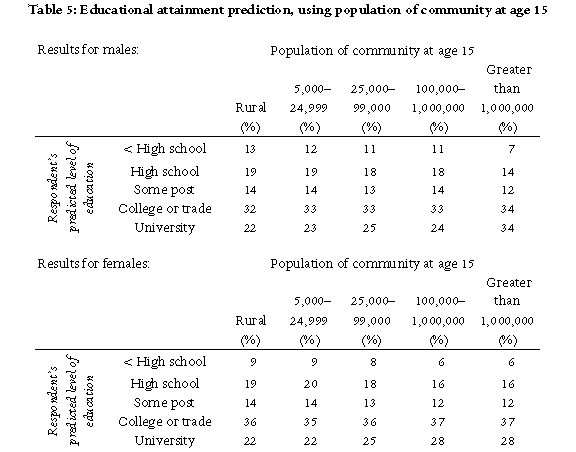
Conclusion
Our results confirm earlier researchers’ findings that, in the prediction of the child’s educational attainment, virtually the only factor that is of importance is the education of the parents. Most importantly, the children of parents with less than high school education are much less likely to proceed beyond high school than are the children of parents at other educational levels. And the children of parents with university degrees are much more likely to complete university themselves than are the children of parents with lesser education.
Nevertheless, we also found that the education levels of the child’s parents were only indicative of a child’s educational attainment. The only situation in which 50 percent of the children of a set of parents had the same educational level as their parents (when both parents had the same education) was that in which both parents had university degrees. In every other case, it was rare for the probability that children would share their parents’ educational attainment to exceed 33 percent. This strongly suggests that, in the prediction of a child’s educational success, experts should generally present at least two (and, more often, three) alternative scenarios.
![]()
